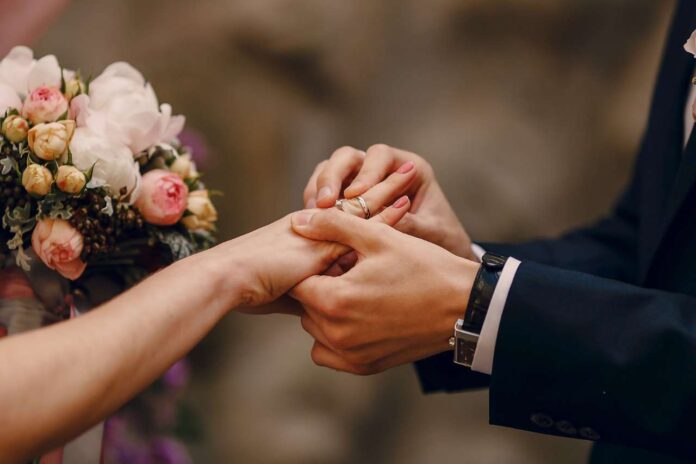Weddings, those joyous occasions of love where the marrying couple makes a public commitment, a vow to navigate life together, come what may.
Have you ever wondered what the origins of weddings were, where all the superstitions came from and what they symbolize?
Over many centuries, weddings have gone from simple agreements and family ties to fancy events reflecting the personalities and beliefs of the couple.
Let’s take a look at the history of weddings, how some traditions have changed, and how we still incorporate many of the old ideas when planning them.
What is the history of weddings?
Credit: Brides Magazine
According to The Week, the earliest record of weddings is thought to be about 4,350 years old as there is evidence of a marriage ceremony that took place in Mesopotamia circa 2350 BC. The reasons for marrying and the ceremony itself evolved over the years. Marriage had a specific purpose; it was not always about spending your life with someone you’ve chosen as a life partner.
Its purpose was intended to bind women to men so that children borne of that union are definitively theirs. Once married, a wife became a husband’s property. In ancient Greece, the practice was for the father of the bride to give his daughter to her intended by saying these words:
“I pledge my daughter … to you …
for the purpose of producing legitimate offspring.”
It was definitely a transactional event, and this is where the “giving the bride away” symbolism comes from.
Why is June a popular month for weddings today?
There are a few reasons for this. One is that the month of June is named after the Roman goddess of marriage, Juno. This was at a time when it was believed that if couples married during the month of June, they would be eternally happy.
In addition, during Victorian times, bathing was considered a medical treatment. Therefore, people usually only bathed about once a week during that time. Fresh, fragrant flowers were more available during June which would help mask what body odors were present.
Wedding Superstitions and Beliefs
Weddings are made magical with their superstitions, traditions and beliefs. Here are just a few common traditions.
Credit: Raw Pixel
- White Wedding Dress & Veil: Though this is a relatively new practice, today, many brides will wear white wedding dresses and veils as white represents purity.
In 1559, Mary, Queen of Scots wore a white wedding gown when she married Francis Dauphin of France. However, white wedding dresses did not become common until Queen Victoria wore a white court dress to her wedding in 1840 to Prince Albert.
The wedding veil dates back to Greek and Roman times and was believed to hide the bride from “evil spirits” wanting to foil her joy.
Check out this post from The White Collection.
Fun fact: After World War II, some brides made their wedding dresses from parachutes.
- The Rings: Today, as in the past, engagement and wedding rings symbolize love, commitment and devotion. Engagement rings were once viewed as security deposits that ensured a man’s promise was solid. A wedding ring on either the bride or the groom represents many things such as: love and commitment and the couple’s emotional bond. As wedding rings are usually round bands and have no beginning or end, they also represent eternal love and the endless cycles of life and love.
- Rain on Your Wedding Day: No one who is wearing a floor length wedding dress wants to ruin it with dirty rainwater from puddles, not to mention the risk of the bride ruining her hair and makeup in the rain. But it is believed to be good luck if it rains on your wedding day.
- Tossing of the Bouquet/Garter Belt:
- Tossing the Bouquet: At some point during the ceremony, the bride might gather up all the single ladies for the Bouquet Toss. This is a tradition that began in medieval Europe, and it was meant as a way to distract guests from tearing the bride’s wedding dress for good luck. It also is alleged to predict who will be next to be married.
- Tossing the Garter Belt: This too was used as a way to distract guests during the celebration. The groom will gather up all the single men and toss the garter into the group. Some believe catching the garter will bring good luck, but it also symbolizes the newlyweds consummating their marriage. This is because during the Middle Ages, guests would wait outside the newlyweds’ bedroom while they consummated their marriage. Afterward, the groom would toss the garter belt out the room to confirm they had done the deed.
Updated Wedding Traditions
There are other ways to have a wedding. Here are a few:
- On the heels of the COVID pandemic, large gatherings were given the side eye and prices went up everywhere. So, why not elope and have a small gathering after?
- Thinking about the bouquet toss? Skip it! Why highlight single women at such an event? Why not gift the bouquet to the longest married couple in attendance?
- Must a bride wear white? Absolutely not! Some brides have even opted to wear black!
- Skip the registry! Isn’t the presence of those you love celebrating your new life with you enough?
Allureone has posted an article that offers some original ideas.
These are some of the more common wedding traditions. If you want to read more, check out these articles in Brides, photographer Carla Thomas’ blog post, and this one in The Knot for more.
Over the years, what were once simple agreements cementing family alliances grew to become today’s elaborate productions highlighting the personalities of the featured couple. Whether the couple is a traditional heterosexual one, a racially mixed one or a gay couple, wedding ceremonies are intimate affairs that present an opportunity to celebrate not only the union of two families, but the presence of love, even in this day and age when we live in a more accepting world that still has plenty of work to do.
Follow your heart and create a path for a happy, joyful partnership with the person you love that will last a lifetime.


